当前位置:
X-MOL 学术
›
Earth Surf.Process. Land.
›
论文详情
Our official English website, www.x-mol.net, welcomes your feedback! (Note: you will need to create a separate account there.)
The influence of channel morphology on bedload path lengths: Insights from a survival process model
Earth Surface Processes and Landforms ( IF 3.3 ) Pub Date : 2020-07-03 , DOI: 10.1002/esp.4946 Conor McDowell 1 , Marwan A. Hassan 1
Earth Surface Processes and Landforms ( IF 3.3 ) Pub Date : 2020-07-03 , DOI: 10.1002/esp.4946 Conor McDowell 1 , Marwan A. Hassan 1
Affiliation

|
Tracer studies are a commonly used tool to develop and test Einstein‐type stochastic bedload transport models. The movements of these tracers are controlled by many factors including grain characteristics, hydrologic forcing, and channel morphology. Although the influence of these sediment storage zones related to morphological features (e.g., bars, pools, riffles) have long been observed to “trap” bedload particles in transport, this influence has not been adequately quantified. In this paper we explore the influence of channel morphology on particle travel distances through the development of a Bayesian survival process model. This model simulates particle path length distributions using a location‐specific “trapping probability” parameter (pi), which is estimated using the starting and ending locations of bedload tracers. We test this model using a field tracer study from Halfmoon Creek, Colorado. We find that (1) the model is able to adequately recreate the observed multi‐modal path length distributions, (2) particles tend to accumulate in trapping zones, especially during large floods, and (3) particles entrained near a trapping zone will travel a shorter distance than one that is further away. Particle starting positions can affect path lengths by as much as a factor of two, which we confirm by modelling “starting‐location‐specific” path length probability distributions. This study highlights the importance of considering both tracer locations and channel topography in examinations of field tracer studies. © 2020 John Wiley & Sons, Ltd.
中文翻译:

通道形态对床荷路径长度的影响:来自生存过程模型的见解
示踪剂研究是开发和测试爱因斯坦型随机床载运输模型的常用工具。这些示踪剂的运动受许多因素控制,包括谷物特征,水文强迫和河道形态。尽管长期以来观察到这些与形态特征相关的沉积物存储区的影响(例如,条形,池形,浅滩形)在运输过程中“捕获”了床荷颗粒,但这种影响尚未得到充分量化。在本文中,我们通过建立贝叶斯生存过程模型来探索通道形态对粒子传播距离的影响。该模型使用位置特定的“捕获概率”参数(p i),它是使用床褥示踪剂的开始和结束位置估算的。我们使用来自科罗拉多州Halfmoon Creek的现场示踪剂研究测试了该模型。我们发现(1)该模型能够适当地重建观察到的多峰路径长度分布,(2)粒子倾向于在诱集区内积聚,尤其是在大洪水期间,(3)夹带在诱集区附近的粒子将行进比更远的距离短。粒子的起始位置可能会影响路径长度多达两倍,这可以通过对“特定于起始位置”的路径长度概率分布进行建模来确认。这项研究强调了在现场示踪剂研究检查中同时考虑示踪剂位置和通道地形的重要性。分级为4 +©2020 John Wiley&Sons,Ltd.
更新日期:2020-07-03
中文翻译:

通道形态对床荷路径长度的影响:来自生存过程模型的见解
示踪剂研究是开发和测试爱因斯坦型随机床载运输模型的常用工具。这些示踪剂的运动受许多因素控制,包括谷物特征,水文强迫和河道形态。尽管长期以来观察到这些与形态特征相关的沉积物存储区的影响(例如,条形,池形,浅滩形)在运输过程中“捕获”了床荷颗粒,但这种影响尚未得到充分量化。在本文中,我们通过建立贝叶斯生存过程模型来探索通道形态对粒子传播距离的影响。该模型使用位置特定的“捕获概率”参数(p i),它是使用床褥示踪剂的开始和结束位置估算的。我们使用来自科罗拉多州Halfmoon Creek的现场示踪剂研究测试了该模型。我们发现(1)该模型能够适当地重建观察到的多峰路径长度分布,(2)粒子倾向于在诱集区内积聚,尤其是在大洪水期间,(3)夹带在诱集区附近的粒子将行进比更远的距离短。粒子的起始位置可能会影响路径长度多达两倍,这可以通过对“特定于起始位置”的路径长度概率分布进行建模来确认。这项研究强调了在现场示踪剂研究检查中同时考虑示踪剂位置和通道地形的重要性。分级为4 +©2020 John Wiley&Sons,Ltd.



























 京公网安备 11010802027423号
京公网安备 11010802027423号